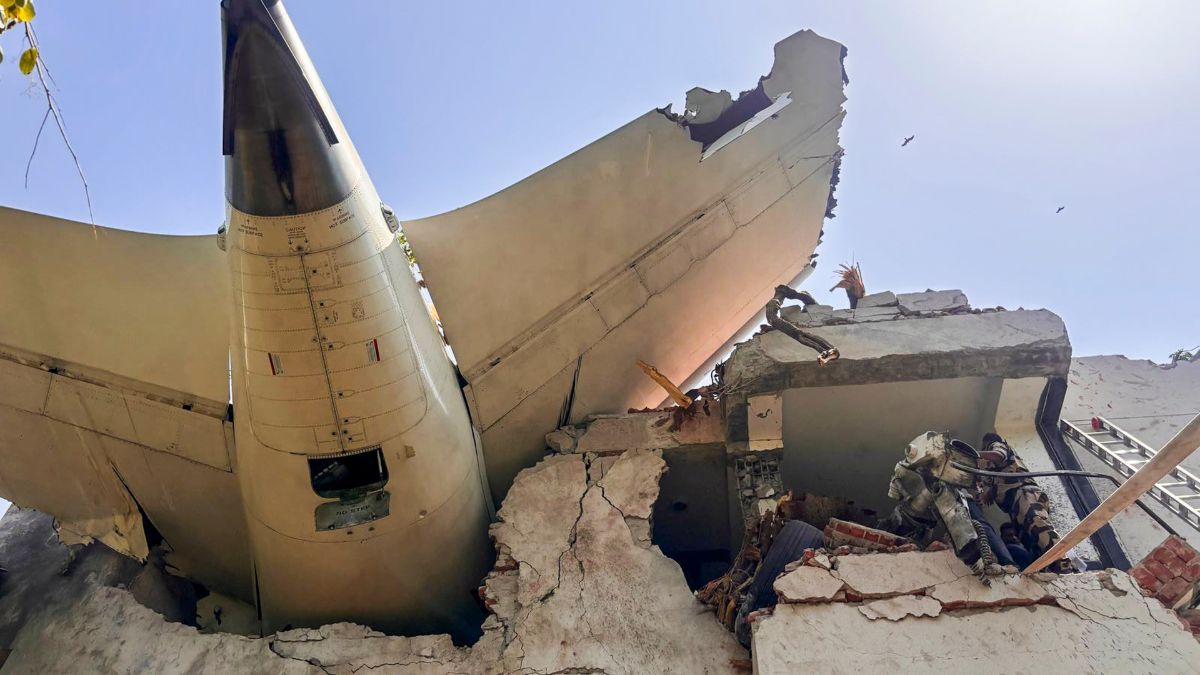While the preliminary Air India plane crash report mentioned that the fuel cutoff to both engines led to the crash of Boeing Dreamliner 787-8, it has opened a can of other unanswered questions. The 15-page report covers the 98 seconds from the plane’s takeoff roll to its devastating crash in Ahmedabad, which ultimately killed over 260 people.
The findings released by India’s Aircraft Accident Investigation Bureau (AAIB) found that switches in the cockpit that controlled fuel moved to a “cutoff” position, leading to the fatal crash. “The aircraft achieved the maximum recorded airspeed of 180 knots IAS [indicated airspeed] at about 08:08:42 UTC, and immediately thereafter, the engine 1 and engine 2 fuel cutoff switches transitioned from RUN to CUTOFF position one after another with a time gap of 1 second," the report said. “The engines N1 and N2 began to decrease from their takeoff values as the fuel supply to the engines was cut off.”
Hence, the engine fuel cut-off was determined as the technical cause of the crash. However, there is more to the story. Transitioning the switches from “Run” to “Cut-off” is not an easy task. The audio retrieved from the aircraft’s black box also raised more questions about what was happening inside the cockpit at the time of the crash. Along with this, AAIB’s conclusion of “not recommending” any actions to Boeing and GE at this stage of the investigation raises speculations on the responsibility of both companies.
Here’s a look at some of the key questions Air India report remained unanswered:
The unanswered questions
How did the switches transition from ‘Run’ to ‘Cutoff’
One of the key aspects of the report was the transition of the engine fuel switch from “Run” to “Cutoff”. The switches transitioned one after another with a time gap of just 1 second. As a result, the Engine N1 and N2 began to decrease from their take-off values as the fuel supply to the engines was cut off.
However, it is not an easy task to transition the switch to the off position due to the aircraft's design. On the Boeing 787 Dreamliner, the two fuel cutoff switches sit between the pilots’ seats, right behind the throttle levers.
These switches are flanked by a metal bar and have a lock to prevent them from accidentally transitioning. Hence, the switches are “designed to be moved intentionally,” to avoid such accidents. While speaking to CNN, aviation safety expert, David Soucie, said: “Throughout the years, those switches have been improved to make sure that they cannot be accidentally moved and that they’re not automatic. They don’t move themselves in any manner."
Impact Shorts
View AllAs per the Enhanced Airborne Flight Recorder, the E1 fuel cut-off switch was transitioned back to “Run”, and the same was done to the E2 cut-off switch. This resulted in a relight and thrust recovery sequence of ignition and fuel introduction. Engine 1 started the core recovery, but Engine 2 could not arrest the core speed after fuel re-introduction.
While the report detailed the transition of the switches, it doesn’t mention who or how these switches were transitioned from Run to Cut-off in the first place. The cockpit audio recording makes things more complicated.
Was it a pilot error or another form of negligence?
- Who said what?
As per the AAIB report, the cockpit voice recording captures one of the pilots asking the other, “Why did he cut off?”. The other pilot responded that “he did not do so”. Now the two pilots inside the cockpit were Sumeet Sabharwal, 56, who had a total flying experience of 15,638 hours, and Clive Kunder, 32, who had 3,403 hours of total experience. Hence, both pilots had solid flying experience.
So, if the pilot did not transition the switches, then who did? Was it a malfunction of some sort? Not only this, the report also did not mention who said what in the recording, leaving the matter unanswered.
- The 2018 warning
Now there is another side to the story. The report noted that the FAA issued Special Airworthiness Information Bulletin (SAIB) No. NM-18-33 on December 17, 2018. The bulletin was regarding the “potential disengagement of the fuel control switch locking feature.”
The SAIB was issued after the operators of Boeing Model 737 stated that the fuel control switches were installed with the locking feature disengaged. However, the concern at that time was not considered unsafe, which would have warranted an airworthiness directive
(AD) by the FAA.
The AAIB stated that Air India told the investigators that the suggested inspections were not carried out since the SAIB was advisory and not a mandatory directive. While the scrutiny of the maintenance records revealed that the throttle control model was replaced on VT-ANB in 2019 and 2023, the reason for the replacement was not linked to the fuel control switches.
The report maintained that there has been no defect reported about the fuel control switch since 2023. So, how did it transition, if the pilots claimed they did not do it and if there was no defect reported?
Why did the engine not recover
In the report, it was mentioned that the Air India pilots attempted to restart the engine after the fuel was cut off. When the engine fuel was shut off, the Ram Air Turbine - a small propeller-like device - was deployed automatically to provide emergency hydraulic power.
The CCTV footage assessed by the authorities also showed the RAT being deployed. The pilots tried to restart the engine. N1 or engine 1 was partially recovered, but engine 2 failed to recover before impact. The aircraft was airborne for only 32 seconds - crashed 0.9 NM from the runway into a hostel of a medical college.
While the thrust levers were found at idle, the black box shows that takeoff thrust was still engaged, suggesting a disconnect/failure. The second engine was mentioned not to arrest the reintroduction of fuel, which still raises questions on whether the engine had some issues. However, it is important to note that AAIB’s 15-page report is just the tip of the iceberg, and further investigation would give clarity on this.
Why was no action recommended for Boeing or GE?
After the report, the AAIB noted that at this stage of the investigation, there are no recommended actions for B787-8 and/or GE GEnx-1B engine operators and manufacturers, meaning Boeing and GE. Has the AAIB report ditched fixing accountability for the Air India plane crash?
There are still questions about how the switches of the Boeing aircraft transitioned when both pilots claimed that they didn’t do it. Why did the second engine not respond to the fuel reintroduction like the first one did?
In the past, multiple whistleblowers raised concerns about the Boeing aircraft. The American planes have also been involved in several aviation accidents recently. Hence, both the engine makers and the manufacturers of the 787 can’t get off the hook.
There is still a long way to go.
Drawing conclusions from the preliminary report is something which is not advisable by the AAIB itself. The Indian authorities maintained that the “document has been prepared based on the preliminary facts and evidence collected during the investigation. The information is preliminary and subject to change.”
The authorities stated that as per Annexe 13 to the Convention on International Civil Aviation Organisation (ICAO) and Rule 3 of Aircraft (Investigation of Accidents and Incidents), 2017, the sole objective of the report was to reveal what went down and not apportioning blame and liabilities on any of the parties.
Similarly, MoS Civil Aviation Murlidhar Mohol said, “The AAIB has brought out a preliminary report. This is not the final report. Until the final report comes out, we should not arrive at any conclusion. AAIB is an autonomous authority, and the ministry does not interfere in their work.”
According to India’s aviation rules, a preliminary report had to be released within 30 days of the incident. However, it could be months before investigators release a full and detailed report into the causes of the crash. Until then, the aforementioned questions might remain unanswered.


)
)
)
)
)
)
)
)
)



